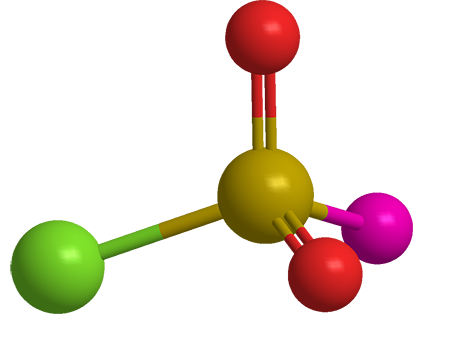What molecule am I?


Sulfuryl chloride fluoride (SO2ClF) is a strong Lewis acid and a useful solvent and reagent. As shown in the hazard information table, it must be handled with care. Its boiling point is in the range that allows its use as a gas or a liquid.
In the 1930s, Harold Simmons Booth* and Carl V. Herrmann at Western Reserve University (Cleveland; later Case Western Reserve University) performed pioneering work on SO2ClF. They synthesized it via the reaction of sulfuryl chloride (SO2Cl2) and antimony trifluoride (SbF3) in the presence of antimony pentachloride (SbCl5). They also measured several properties of SO2ClF, including boiling point, melting point, liquid density, vapor pressure from –89 to +9 ºC, heat of vaporization, and surface tension.
But the real champion of SO2ClF was the 1994 chemistry Nobelist George A. Olah. In 1967, also at Case Western, Olah and Joachim Lukas used the solvent system SO2ClF–fluorosulfonic acid (FSO3H)–antimony pentafluoride (SbF5) to generate stable alkylcarbonium ions (now called carbocations)—from simple ones such as Me3C+ and Me2EtC+ through cations containing as many as nine carbon atoms. Acid mixtures like the ones they used came to be known as superacids.
In 1976, Olah, Mark R. Bruce, and John Welch developed an improved synthesis of SO2ClF by adding SO2Cl2 to pyridinium poly(hydrogen fluoride) under mild conditions. By the early 1980s, now at the University of Southern California (Los Angeles), Olah and co-workers developed SO2ClF as a versatile reagent. Some SO2ClF applications include
- a dehydrating agent for converting aldoximes to nitriles;
- in combination with triethylamine, a reagent for making amides from carboxylic acids and primary amines and esters from carboxylic acids and alcohols;
- in combination with sulfur trioxide, an oxidant for converting tertiary phosphines and arsines to their corresponding oxides; and
- in combination with SO2Cl2, a reagent for converting enol silyl ethers to α-chloro ketones.
Finally, in 1992, V. Prakash Reddy, Donald R. Bellew, and G. K. Surya Prakash* at USC reported another useful synthesis of SO2ClF, from SO2Cl2 and ammonium or potassium fluoride in the presence of trifluoroacetic acid. Surya Prakash was a student of Olah and is his successor as the director of USC’s Loker Hydrocarbon Research Institute, the location of much of Olah’s carbocation research.
Sulfuryl chloride fluoride hazard information
| Hazard class** | Hazard statement | |
|---|---|---|
| Gases under pressure, liquefied gas | H280—Contains gas under pressure; may explode if heated | |
| Acute toxicity, oral, category 3 | H301—Toxic if swallowed | |
| Acute toxicity, dermal, category 3 | H311—Toxic in contact with skin | |
| Skin corrosion/irritation, category 1B | H314—Causes severe skin burns and eye damage | |
| Serious eye damage/eye irritation, category 1 | H318—Causes serious eye damage | |
| Acute toxicity, inhalation, category 3 | H331—Toxic if inhaled | |
| Specific target organ toxicity, single exposure, respiratory tract irritation, category 3 | H335—May cause respiratory irritation | |
| Simple asphyxiation, category 1 | H380—May displace oxygen and cause rapid suffocation | |
*Compilation of multiple safety data sheets.
**Globally Harmonized System of Classification and Labeling of Chemicals.
Explanation of pictograms.
This molecule was suggested by a reader. We present almost all of the molecules suggested by our readers. If you have a molecule you would like us to consider, please send us a message. And thank you for your interest in Molecule of the Week! —Ed.
Sulfuryl chloride fluoride fast facts
| CAS Reg. No. | 13637-84-8 |
| SciFinder nomenclature | Sulfuryl chloride fluoride |
| Empirical formula | ClFO2S |
| Molar mass | 118.52 g/mol |
| Appearance | Colorless gas or colorless to light yellow liquid |
| Melting point | 7.1 ºC |
| Water solubility | Reacts |
MOTW update
cis,trans-Nepetalactone was the Molecule of the Week for February 15, 2010. It is the primary psychoactive ingredient in catnip (Nepeta cataria). In 2009, it was the starting material for synthesizing (+)-englerin A, a promising kidney cancer drug candidate.
It has long been known that catnip repels mosquitoes; but until this year, the repellence mechanism was unknown. Marcus Stensmyr and co-workers at Lund University (Sweden) discovered that nepetalactone activates a receptor in mosquitoes that makes them feel pain. Cats, among many other animals, have the same receptor; but clearly the effect is different for them.

Learn more about this molecule from CAS, the most authoritative and comprehensive source for chemical information.
Molecule of the Week needs your suggestions!
If your favorite molecule is not in our archive, please send us a message. The molecule can be notable for its current or historical importance or for any quirky reason. Thank you!
Stay Ahead of the Chemistry Curve
Learn how ACS can help you stay ahead in the world of chemistry.

